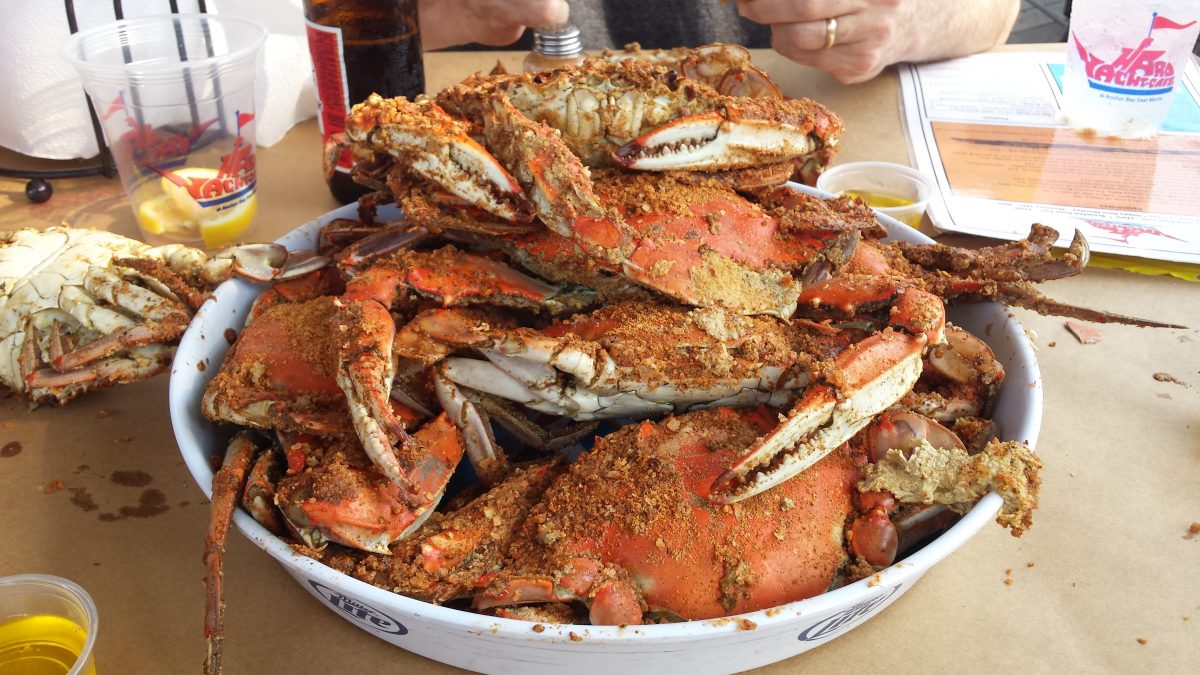
Bill Wade was first introduced to the Chesapeake Bay on his parents’ boat at Kent Island, a vessel that his mother had won from a car dealership jingle-writing contest. Bill’s wife, Susan, was raised an inlander in Western Pennsylvania. But she was quickly converted. “If you follow the seasons around the bay, there’s always something unique there,” says Susan. “And this estuary produces such amazing seafood all year round.”
The Wades’ love of crabs and seafood has taken them to hundreds of crab decks in the area. Given their eating escapades, a friend suggested they create a book of every restaurant they’d visited through the years. “After many beers we thought it was a great idea, and the next morning we woke up and it still sounded like a good idea,” says Bill. And so their book Crab Decks & Tiki Bars of the Chesapeake Bay was born. Over a crab feast at Hard Yacht Cafe in Dundalk (naturally), we sat on a crab deck to talk about the Wades’ latest venture.
What inspired the idea of creating this book?
Bill: It’s kind of known in our circle that anytime someone’s going somewhere they would give us a ring and say, “Hey, we’re going to Dundalk,” or “We’re going to Chesapeake Beach, what would you recommend?” We had our own little stockpile of knowledge that we’d give recommendations from. And then we thought, “Well, how many can there be?” We started hitting them—we didn’t know what we were in for.
Susan: All of these places are hidden in these folds and necks and coves. Each one is unique, each one has its own personality, they’re so different.
Bill: We really started having fun, so we kept doing it.
How did you decide where to go?
Susan: Bill’s definitely a meticulous researcher. But we set criteria that we wanted them to be on or really close to the water. If you want the bay experience, you have to be by the water.
Bill: You have to take a leap of faith and drive down some back road. Aim for the masts. Susan: And the smell of the water.
Are there different techniques for preparing crabs?
Bill: The biggest issue is the seasoning. People have figured out over time you steam them for 25 minutes. In Louisiana, they boil them. Every year there’s a steaming vs. boiling contest, and every year Maryland wins with steaming. A steamed crab is a steamed crab, but everyone always has spices that they talk about.
Did you ever get sick of eating crabs?
Bill: I bet I could eat a crab or crab cake every day of the year and really not get tired of it.
Susan: I have to pace myself; I have to eat other things.
Bill: We went to plenty of places where honestly we just had a cocktail and soaked in the atmosphere. You can’t go out to 200 restaurants in the on season, there aren’t enough nights. And we have regular lives, so we had to do a little bit of corner cutting.
Susan: People around the bay are really ingenious with what to do with crabs, like the crab pretzels, the crab eggrolls, and the crab quesadillas. They’re rather inventive with what you can do, so that’s been the thing that’s sustained me, so I don’t have to sit for hours and pick crabs. I can get a crab cake, or crab balls, or crab nachos. That’s how I survived all that crab.
Would you say that eating at crab decks like this is a part of our regional identity?
Bill: Virginia is for lovers and Maryland is for crabs—it is the identity of the state.
Susan: Down in southern areas like Louisiana you have these temperate climates year round, but in Maryland you’ve got hot summers and really cold winters. So when crabs hibernate in the fall, they develop a fattiness to survive the cold winters as they burrow into the sand. They develop a sweeter flavor than ones that always live in warm climates.
Bill: The overwhelming majority of these are unique because they’re all the one restaurant owned by the one family, sometimes for generations. You wont find this anywhere else.
Susan: What we’ve seen at these little waterfront family owned places is this determination not to let the traditions of the Chesapeake Bay die. It’s not just the nautical sailor, and it’s not the war of 1812, it’s these guys busting their humps running the marina and surviving whatever comes their way.
What was your main goal in writing this book?
Susan: The goal was to share our experiences on the bay. Another goal was to help promote these businesses out here. I would also like to get people off the couch and to go to the bay. Go to a place where there are no more road signs and your GPS might blank out, but have an adventure. It’s not that far, follow the water up, eventually, you’ll get back to Baltimore.
